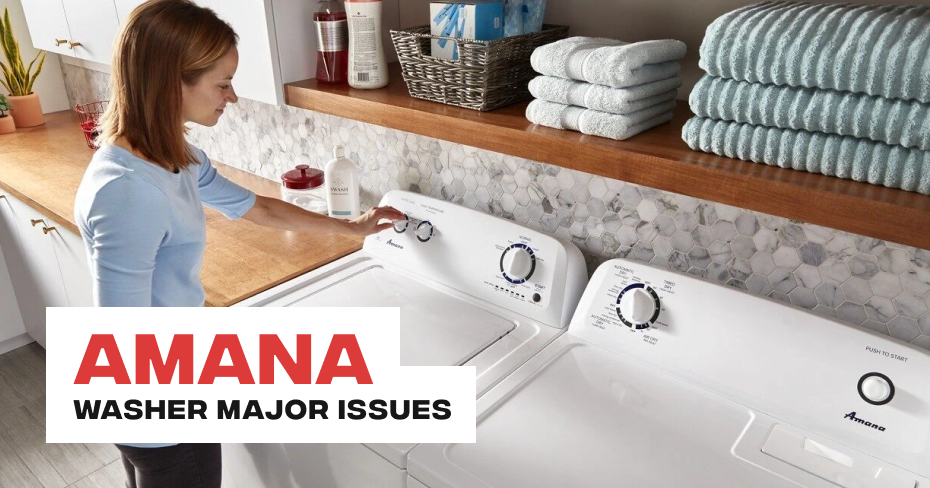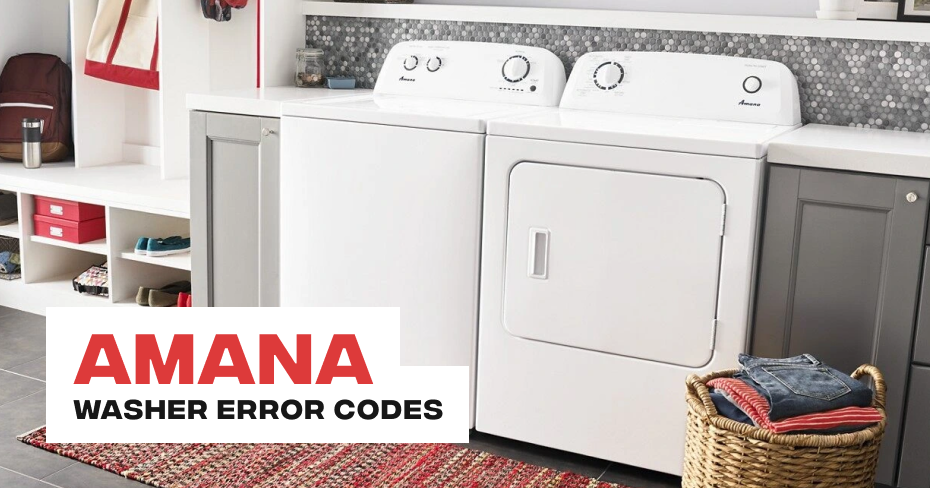Amana Washer Spin Cycle Issues
There are several reasons why an Amana washer will not spin, with one of the most common being a worn-out drive belt. If you have a top-load washer, the next most likely cause is a defective lid switch, followed by a defective motor coupler.
With front-load washers, a defective door lock can also cause the washer not to spin. Another common cause is a worn-out motor coupler. Fortunately, with this guide to help you, it is relatively easy to find the problem and replace the defective component.
Make sure to disconnect the power and water before accessing the washer.
Top-Load Washers
1. Defective Lid Switch
The washer’s lid switch is a safety feature designed to stop the washer from spinning when the lid is open. While some washers will not operate at all if the lid switch is defective, others may fill with water and agitate but not spin.
The lid switch on an Amana top-load washer is usually located in the upper left corner of the top of the washer, underneath the control panel. To access and check the lid switch, the control panel needs to be lifted up by removing the screws at the back of it.
Once you have located the lid switch, disconnect the wiring harness, and test the switch for continuity with a multimeter. Depending on the type of multimeter you have, with the meter set to ohms, you should get a reading of 0.1 or close to it, which indicates a completed circuit.
When the lid is opened, the multimeter should show a reading of 1, which means the lid switch does not have a completed circuit and is, therefore, working correctly (shutting off the washer when the lid is open).
If there is no continuity (a completed circuit) when the lid is closed, indicated by a multimeter reading of 1 (depending on the type of multimeter), the lid switch is defective and needs to be replaced.
2. Defective Motor Coupler
If you have a direct-drive washer that uses a motor coupler, the coupler may have worn, which causes the washer not to spin. A motor coupler sits between the motor and the transmission and is made up of two drive cams with a rubber cushion between them. When the washer is operating normally, the motor turns one of the drive cams, and the coupler transfers that power to the second drive cam, which allows the washer to spin.
A worn-out motor coupler may allow the washer to agitate, usually when the load size is small, but the washer will not spin. If you hear a loud, unusual noise and notice that the coupler is slipping, the motor coupler most likely needs to be replaced.
To access the motor coupler, you will need to put the washer on its back and locate the pump and the motor at the base of the washer. The pump will need to be removed, along with the motor, to access the coupler, which is on the transmission. You should be able to easily remove the coupler, check it for wear and tear, and then replace it if necessary.
Front-Load Washers
1. Defective Door Lock Switch
Like a top-load washer’s lid switch, front-load washers have a door lock switch that shuts off the washer when the door is opened. If the door lock is defective, the washer will not spin.
The door lock can fail both mechanically and electrically. Typically, you will be able to see if the door latch is not latching properly and whether it can be fixed or if it needs replacing.
To test if the door lock has failed electrically, the door lock will need to be removed and tested with a multimeter for continuity. If the door lock does not have continuity, it will need to be replaced to fix the washer.
Top and Front Load Washers
1. Worn Drive Belt
If the washer is a belt-drive washer, one of the most common reasons why it will fail to spin is a broken or worn drive belt. If the belt is worn, it may be able to agitate the washer but not spin the tub. If the belt is broken, it will not be able to agitate or spin.
With a front-load washer, the belt is located behind the tub and will require the back panel of the washer to be removed. With top-load washers, the belt is located at the base of the washer, and the washer will need to be put on its back to access the belt.
Once you have accessed the drive belt, check it for signs it is defective, such as signs of overheating or burning, traces of oil or lubricant on the belt, and general wear-and-tear. If the belt is defective, it is relatively easy to remove and replace the belt to fix the washer.
Some belt-driven washers may have two belts, one to control the pump and one to control the transmission. The transmission belt is the one that may be preventing the washer from spinning.
2. Defective Stator or Rotor
Depending on the model, the washer may have a stator and rotor assembly, which interact to create a magnetic field that spins the tub. Over time, the stator windings or rotor magnets can become damaged, which causes the washer not to spin or agitate.
With a front-load washer, the stator and rotor will be located at the back of the washer, behind the tub. If you have a top-load washer, the stator and rotor will be located at the base of the washer, underneath the drum.
Once you have located the stator and rotor, check if any stator windings are broken and if the rotor shows signs of wear-and-tear. The stator can also be tested with a multimeter to determine if it needs to be replaced.
Conclusion
Hopefully, the steps above have allowed you to fix your Amana washer. If the issue remains, it is probably time to call a trained technician to further troubleshoot the issue.
Amana Washer Error Code F# E# code
Welcome to our dedicated page on Amana Washer Error Codes, where we delve into the world of Amana appliances and offer insights into resolving issues you may encounter. One common error code you might face is the Amana Washer Error Code F# E#, indicating an “other error.”
If you find this code displayed on your washing machine, it signifies a miscellaneous issue within the appliance’s system. Fortunately, there are steps you can take to address and potentially resolve this error on your own.
To begin, initiate a power cycle. Turn off your Amana washer and unplug it from the electrical outlet. Allow the machine to sit without power for a few minutes, ensuring a complete reset. After this brief interruption, plug the washer back in securely.
Restart the washing machine and attempt to initiate a wash cycle. Monitor the appliance closely to see if the F# E# error code persists. This simple power cycle is designed to eliminate temporary glitches and address internal malfunctions that may be triggering the error.
As your washing machine resumes operation, observe its performance during the wash cycle. Confirm whether the error code reoccurs or if the reset has successfully resolved the issue. If, however, the F# E# error persists, it may indicate a more complex problem that requires professional attention.
In such cases, don’t hesitate to contact the experts at Appliance Repair Los Angeles. Our skilled technicians are well-versed in diagnosing and resolving various washer issues, including Amana Washer Error Codes. Give us a call at 323-792-1970 to schedule a service appointment and ensure your Amana washer operates at its best.
Don’t let an error code disrupt your laundry routine. Trust Appliance Repair Los Angeles to provide timely and effective solutions for your Amana washer concerns. We are here to make sure your appliances work seamlessly, allowing you to focus on what matters most.


